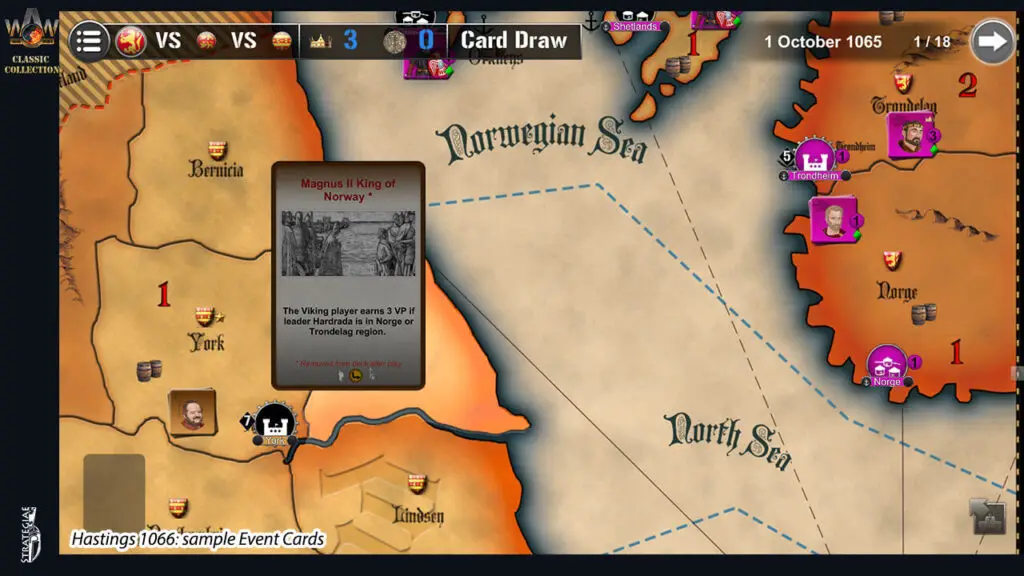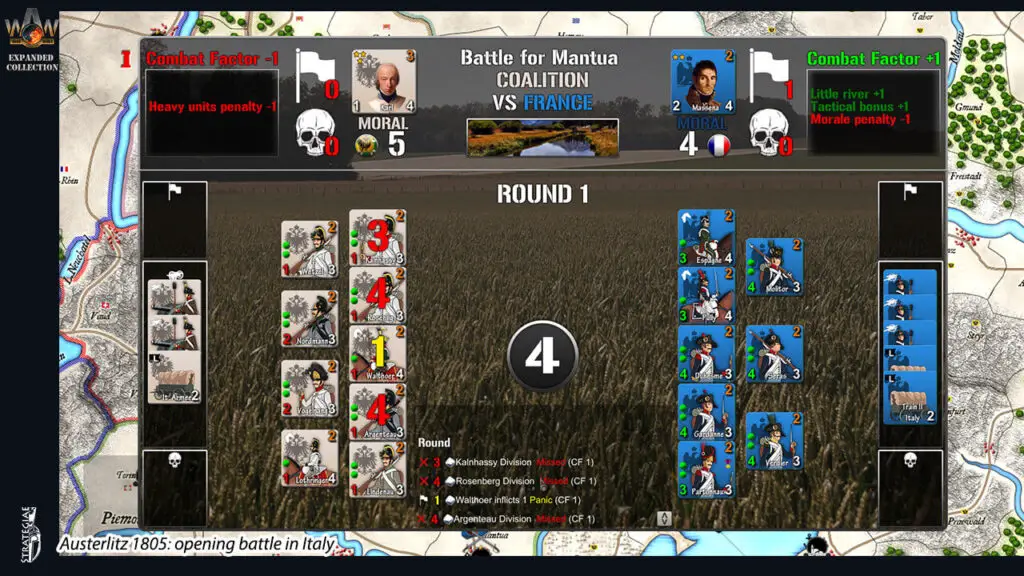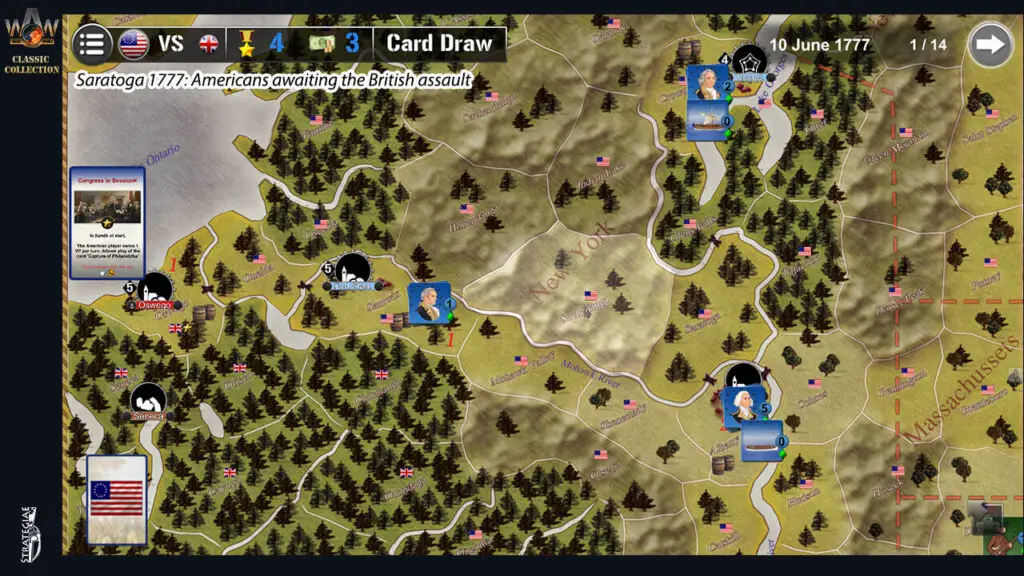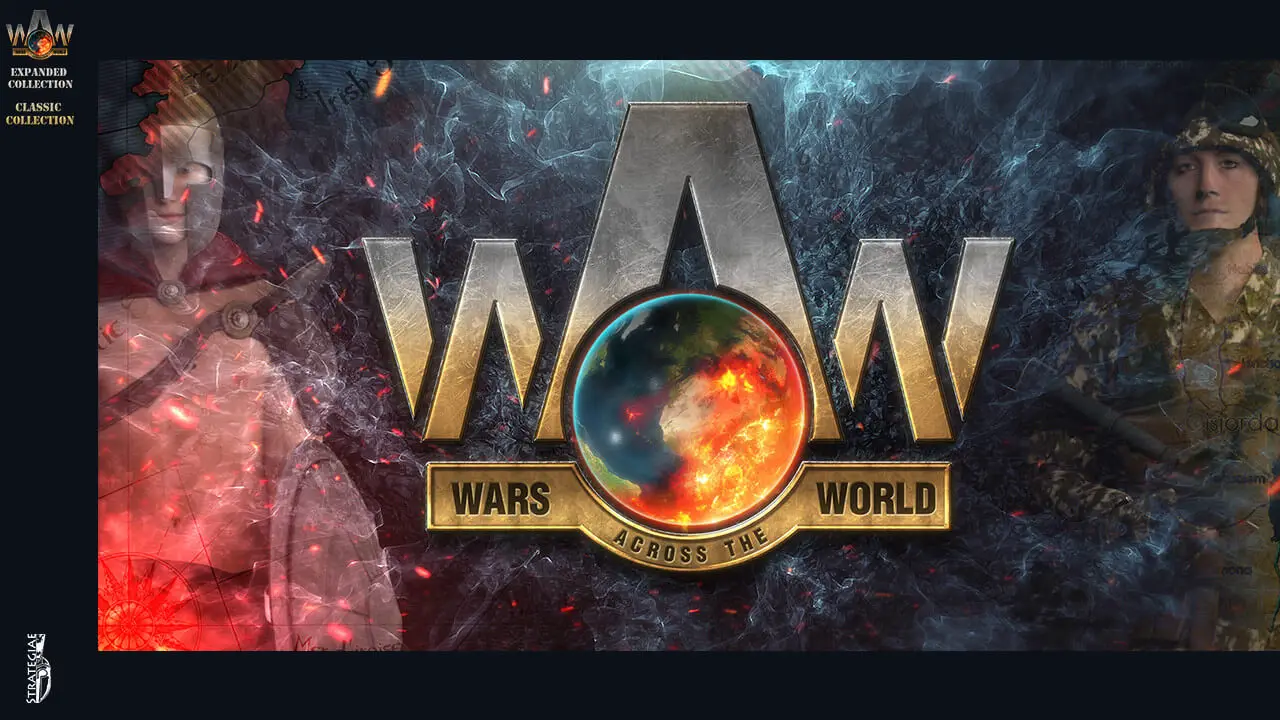French producers Avalon Digital made a bold claim when they began to promote Wars Across the World: that they could model almost any historical war or battle and there’s “just one rule” that applies across them. The game, first released in 2017 came loaded with several scenarios, ranging from ancient Rome all the way up to the Six Days War of 1967. So how well does the game manage to handle such a broad range of time periods and wars?

Wars Across the World (referred to informally as WAW) is a turn-based strategy game, with most of its scenarios for between one and three players. There’s no campaign, just a series of scenarios about different battles and wars throughout history. There’s a definite board-game feel with a “board” area on the map, representing the playable area, divided up into areas. A novel approach sees many maps including “off map” holding areas, such as the Israel box in the Yom Kippur scenario, only accessible by the Israeli player.
The map can be left in its natural colours or you can have the map coloured to show which faction has control there. Otherwise, each area of the map has control denoted by small flags. With such a broad range of history to talk about, a map may contain anything from a castle all the way up to a modern urban city. Each scenario lays out any rules for movement but there are some generic rules that always apply.
Units, which can represent anything from a few hundred men to an entire army corps are rated for movement, combat, morale, and special skills. They can also have strength points, which determine how many times in combat they can be hit before being removed from play. As well as fighting units, a player will also need access to leaders. A stack of units can only make attacks against other stacks of units if a leader is present, which offers an interesting challenge of where to place them. You can still maneuver your combat units without them, creating bottlenecks and leaving roadblocks in the enemy’s way but major offensives need someone to call the shots.

Much like fighting units, leaders also have their own stats, including a star system for their level of command, which determines how many units they can competently lead in battle. This will also determine the “priority” of the leaders if there is more than one in the same battle area. Some scenarios include Kings or Emperors who outrank everyone but are not always cut out to lead an army!
Most but not all scenarios include some light supply rules whereby armies must be able to trace a line of supply back to a logistics base, be it a castle or a forward operating base. Some scenarios do away with supply where they don’t really fit, Hastings 1066 has no lines of supply for example. There’s also a purchasing step every other turn, though again not in every scenario where you gain gold based on the areas of the map you hold, which can be used to purchase new units, replacement steps for damaged units, and cards.
The cards are a big part of the game. Each side starts with a hand of cards, drawing at least one new card per turn. These cards provide both the “gotcha” moments where you can block an enemy’s retreat, deploy new units, modify the game’s political scores or just trigger a games event, such as bad weather or a general dying of old age and being replaced. Some cards are marked that they have to be played but you’re often compensated with a replacement card. These cards introduce an unpredictable element to the game as well as giving scenarios a bit of replayability.
Many scenarios have a political element, such as the tension with Russians in the Six Days war scenario which can result in intervention or even an instant loss for one side or the other. Otherwise, VP’s are gained for capturing objectives and winning major battles, defined by each scenario. So it is possible to win most of the battles and still lose the war but it has to be said that many scenarios have a tendency to be unwinnable once a side gets a comfortable lead in VPs.

Combat plays out, again with scenario-specific changes, when two armies come into contact. A series of dice rolls are made for each combat unit, modified by terrain, leadership, and morale, and rolls above a certain score will cause units to take a hit, whilst lower scores will either cause a panic, forcing a unit to rout or have no effect at all. Some card play can modify dice rolls or allow rerolls but otherwise your involvement here is to send the army into battle but you don’t choose who attacks who or have any other tactical control. Some units, such as those with the Guard classification can ignore panic results and other units can only deal out panic results, giving you an interesting blend of results and possibilities depending on the scenario and the time period.
So far, so good and the simplicity of the game’s basic engine means that you don’t generally need to learn many new concepts to play scenarios as diverse as Illyria in 270 BC or Rhodesia in the 1970s. The sheer variety of the scenarios give you a wide array, catering to all sorts but the game does a fine job of modeling uprisings and civil wars.
However, the game is not without its problems. A fairly significant one is the poor AI. Playing against the AI is seldom a real challenge as it’ll make puzzling decisions, leave itself wide open to cut off from supply or deploy units and then never move them. You’ll likely get more out of the game if you’ve got a friend you can play against.
There are also issues, if you’re not a native French speaker, of translation. Whilst the meaning is usually discernible, there are numerous examples of language that has either been poorly or directly translated which can leave some strange moments when reading rules or cards.
There are also some issues with game balance, where some scenarios are very one-sided or at least a lot less fun for one side than another. For a veteran wargamer, this is often par the course but some scenarios aren’t all that much fun for one side.
The aircraft rules are also quite difficult to get your head around and often scenarios with a lot of aircraft can take a lot longer.
You can also level fault, if you wish, at the game’s creators for the low price point but that each new scenario must be purchased separately. However, I believe this is more of a feature than a bug. The price point is generally a modest £2 or so and each scenario will yield something in the region of two hours of gameplay, often more. This way you can choose which scenarios you are interested in and then purchase them.
Some of the longer scenarios, such as the Spanish Civil War or the Japanese invasion of Korea in the 16th century can be an epic in their own right.
The game also features a deep, if not exactly user-friendly, editor to allow you to create your own scenarios which you can submit to Avalon and they may even sell them! I’m not sure what the profit share deal on that would be but that’s certainly a nice idea. All in all, WAW is a great little distraction for veteran wargamers, both accessible and varied with a huge variety of battles to fight, even including a couple of truly bonkers scenarios with Innsmouth 1928 and a zombie apocalypse scenario available!









